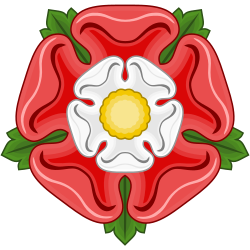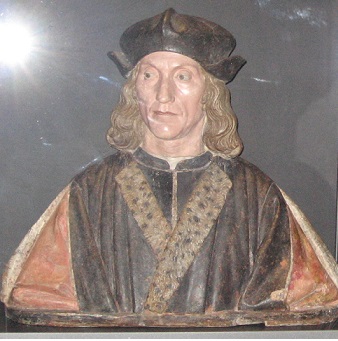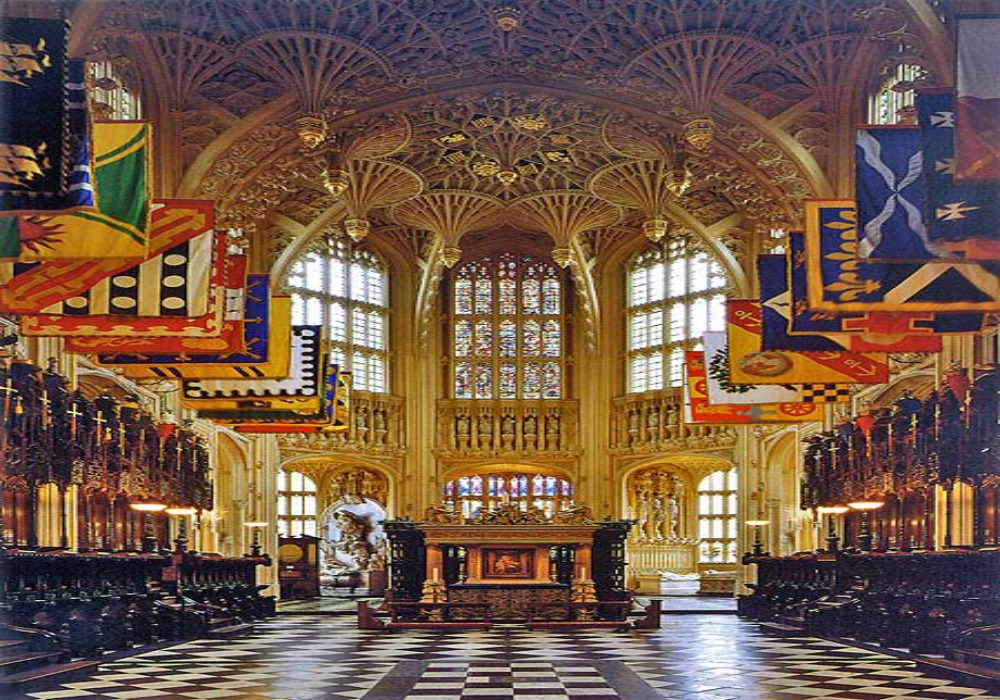by Susan Flantzer © Unofficial Royalty 2016

King Henry VII of England; Credit – Wikipedia
Henry Tudor, the founder of the Tudor dynasty, was born on January 28, 1457, at Pembroke Castle in Wales. Three months before his birth, his father Edmund Tudor, 1st Earl of Richmond died of the plague while imprisoned, leaving a 13-year-old pregnant widow, Lady Margaret Beaufort. Upon his birth, Henry succeeded to his father’s title, Earl of Richmond.

Pembroke Castle in Wales; Photo Credit – Wikipedia
Henry’s father, Edmund Tudor, was the eldest child of Owen Tudor and Catherine of Valois, widow of King Henry V of England. Therefore, Edmund was the half-brother of King Henry VI of England. Owen Tudor’s ancestors were from prominent Welsh families. Catherine of Valois was the daughter of King Charles VI of France and Isabeau of Bavaria. There is much debate as to whether Catherine and Owen married. No documentation of marriage exists, and even if they did marry, their marriage would not have been legal due to the act regarding the remarriage of a queen dowager. King Henry VII of England and the Tudor dynasty descended from Owen Tudor and Catherine of Valois’ relationship. Through their great-granddaughter, Margaret Tudor (Henry VII’s daughter), they are the ancestors of the British royal family and many other European royal families.
Henry’s mother, Lady Margaret Beaufort, was the only child of John Beaufort, 1st Duke of Somerset and Margaret Beauchamp of Bletso. Through her father, Lady Margaret was a descendant of King Edward III of England. Her grandfather, John Beaufort, 1st Earl of Somerset was the eldest child of John of Gaunt, 1st Duke of Lancaster (Edward III’s son), and his mistress Katherine Swynford, whom he married in 1396. Their children were declared legitimate by King Richard II of England and Pope Boniface IX, but their half-brother King Henry IV of England introduced a provision that neither they nor their descendants could ever claim the throne of England. For more details, see Wikipedia: Margaret Beaufort – Ancestry.
At the time of Henry Tudor’s birth, the Wars of the Roses, the fight for the English throne between the House of Lancaster and the House of York, had been occurring for two years. His mother, a descendant of the House of Lancaster, was living at Pembroke Castle under the protection of her brother-in-law Jasper Tudor. Lady Margaret married two more times but had no more children.

Lady Margaret Beaufort, Henry’s mother; Credit – Wikipedia
Jasper Tudor brought up his nephew Henry. In 1461, when the Yorkist Edward IV became king, Jasper went into exile, and Henry became the guardian of William Herbert, 1st Earl of Pembroke. In 1470, the Lancastrian King Henry VI gained the throne again, but six months later, the Yorkist King Edward IV regained the throne, and King Henry VI was murdered in the Tower of London. Jasper left England again for France and took his nephew Henry with him to keep him safe. Jasper and Henry were given refuge by François II, Duke of Brittany. The next thirteen years of Henry’s life were spent in Brittany, and little is known of his life there.
In 1483, King Edward IV died and was briefly succeeded by his young son, King Edward V. Before the young king could be crowned, his father’s marriage to his mother Elizabeth Woodville was declared invalid, making their children illegitimate and ineligible for the throne. King Edward IV’s brother King Richard III assumed the throne. The former King Edward V and his brother Richard, Duke of York (the Little Princes in the Tower) disappeared during the summer of 1483, and their fate is unknown.
Henry Tudor’s mother, despite being married to the Yorkist Thomas Stanley, was actively promoting her son as an alternative to King Richard III. King Edward IV’s widow, Elizabeth Woodville and Henry’s mother made a secret agreement that their children should marry. On Christmas Day in 1483, still in France, Henry pledged to marry King Edward IV’s eldest daughter, Elizabeth of York, who was also Edward IV’s heir since the presumed deaths of her brothers, King Edward V and his brother Richard, Duke of York. In 1485, having gained the support of the Woodvilles, the in-laws of the late King Edward IV, Henry Tudor sailed to Wales with a small French and Scottish force. On August 7, 1485, they landed in Mill Bay, Pembrokeshire, Wales, close to Henry’s birthplace. Henry Tudor then marched towards England, accompanied by his uncle Jasper Tudor and John de Vere, 13th Earl of Oxford.
On August 22, 1485, at the Battle of Bosworth Field, the last significant battle of the Wars of the Roses, the last king of the House of York and the Plantagenet dynasty, 32-year-old King Richard III of England, lost his life and his crown. The battle was a decisive victory for the House of Lancaster, whose leader, 28-year-old Henry Tudor, Earl of Richmond, became the first monarch of the House of Tudor.

Stained glass window in St James Church in Sutton Cheney, England, where it is believed Richard III (left) attended his last Mass before facing Henry VII (right) in the Battle of Bosworth Field; Credit – Wikipedia
Richard had entered the battle as a seasoned soldier, wearing a battle crown on his helmet. During the battle, he saw an opportunity to strike directly at Henry Tudor and his personal guard, and sped off on his horse. After managing to kill Henry Tudor’s standard-bearer, Richard saw something he had not expected. Sir William Stanley, the younger brother of Henry Tudor’s stepfather, changed sides. Instead of supporting Richard and the Yorkists, Stanley attacked them, helping to secure a victory for Henry Tudor and the Lancastrians.
Richard was overwhelmed by Stanley’s soldiers, and at some point, he took off or lost his helmet. Polydore Vergil, Henry Tudor’s official historian, wrote that “King Richard, alone, was killed fighting manfully in the thickest press of his enemies.” According to Welsh poet Guto’r Glyn, the leading Welsh Lancastrian Rhys ap Thomas, or one of his men, killed the king, writing that he “killed the boar, shaved his head.” After the battle, Henry Tudor’s men were yelling, “God save King Henry!” Inspired by this, Thomas Stanley, 1st Earl of Debry, who was married to the new king’s mother, found Richard’s battle crown and placed it on his stepson’s head, saying, “Sir, I make you King of England.”

Finding Richard’s circlet after the battle, Lord Stanley hands it to Henry Tudor; Credit – Wikipedia
Henry Tudor’s first action was to declare himself king by right of conquest. He was crowned in Westminster Abbey on October 30, 1485. King Henry VII did not neglect to reward his supporters. Among them were his uncle Jasper Tudor, who became Duke of Bedford, and his stepfather Thomas Stanley, who became Earl of Derby. Thomas Stanley’s descendant still holds the title. The first Parliament of King Henry VII’s reign was called in November 1485, and a bill was passed confirming Henry’s right to the throne and settling the succession upon the heirs of his body.
Henry VII also honored his pledge to marry Elizabeth of York, King Edward IV’s eldest child, uniting the House of York and the House of Lancaster. On January 18, 1486, the couple were married at the Palace of Westminster. Parliament repealed Titulus Regius, the act declaring King Edward IV’s marriage invalid and his children illegitimate, thereby legitimizing his wife. The Tudor Rose, a combination of the Red Rose of Lancaster and the White Rose of York, symbolized the new House of Tudor.

The Tudor Rose; Credit – Wikipedia

Double Portrait of Elizabeth of York and Henry VII; Credit – Wikipedia
Children of King Henry VII and Elizabeth of York:
- Arthur, Prince of Wales (1486 – 1502), married Catherine of Aragon, no issue
- Margaret Tudor (1489 – 1541), married (1) James IV, King of Scotland, had issue including King James V of Scotland; (2) Archibald Douglas, 6th Earl of Angus, had issue; (3) Henry Stewart, 1st Lord Methven, no surviving issue; Margaret was the grandmother of both Mary, Queen of Scots and Henry Stuart, Lord Darnley, the parents of King James I of England
- Henry VIII, King of England (1491 – 1547), married (1) Catherine of Aragon, had daughter Queen Mary I of England; (2) Anne Boleyn, had daughter Queen Elizabeth I of England; (3) Jane Seymour, had son King Edward VI of England; (4) Anne of Cleves, no issue; (5) Catherine Howard, no issue; (6) Catherine Parr, no issue
- Elizabeth Tudor (1492 – 1495)
- Mary Tudor (1496 – 1533), married (1) Louis XII, King of France, no issue; (2) Charles Brandon, 1st Duke of Suffolk, had issue, grandparents of Lady Jane Grey
- Edmund Tudor, Duke of Somerset (1499 – 1500)
- Katherine Tudor (born and died February 1503) her mother, Elizabeth of York, died as a result of Katherine’s birth

Henry VII’s family: At left, Henry VII, with Arthur, Prince of Wales behind him, then Henry (later Henry VIII), and Edmund, who did not survive early childhood. To the right is Elizabeth of York, with Margaret, then Elizabeth, who did not survive childhood, Mary, and Katherine, who died shortly after her birth; Credit – Wikipedia
During his reign, King Henry VII’s two main goals were peace-keeping and economic prosperity, and he succeeded in both. He did not try to retake the territories lost in France during the reigns of his predecessors. Instead, he concluded a peace treaty with France, which helped fill the coffers of England again. Henry VII made a pact with Spain with the marriage treaty of his eldest son Arthur, Prince of Wales and Catherine of Aragon. He also allied himself with Scotland by marrying his daughter Margaret to King James IV of Scotland. Ultimately, this marriage would unite England and Scotland when King Henry VII’s great-great-grandson, King James VI of Scotland, succeeded King Henry VII’s granddaughter, Queen Elizabeth I of England. Finally, Henry allied with the Holy Roman Empire under Maximilian I. To improve the economic position of England, Henry subsidized shipbuilding, so at the same time, a powerful navy and a large merchant fleet were created.

Bust of Henry VII of England; painted terracotta; made by Pietro Torrigiano; in the Victoria and Albert Museum; Credit – Susan Flantzer
Although King Henry VII is usually considered miserly, he maintained a splendid court, built Richmond Palace, and rebuilt Baynard’s Castle and Greenwich Palace. He founded several religious houses and supported his mother’s educational and religious causes. Perhaps his greatest building legacy is the beautiful Henry VII Chapel in Westminster Abbey, where he and his wife (and many others) are buried.
Arthur, Prince of Wales, Henry’s eldest son and heir, died suddenly in 1502, probably from sweating sickness, shortly after his marriage to Catherine of Aragon. His second son, the future King Henry VIII, became heir and married Catherine of Aragon, the first of his six wives. In 1503, Henry VII’s wife Elizabeth died on her 37th birthday, probably from puerperal fever, shortly after giving birth to her last child, who also died. Henry was grief-stricken, remained in seclusion for six weeks, and would only allow his mother near him. He considered marrying again after Elizabeth’s death, but nothing ever came of it.

Scene at the deathbed of Henry VII at Richmond Palace, 1509; Credit – Wikipedia
Henry’s health began to fail in 1507, and he suffered from attacks of gout and asthma. King Henry VII died at Richmond Palace in Richmond, Surrey, England, on April 21, 1509, at the age of 52. He lies buried with his wife, Elizabeth, in a tomb created by Italian artist Pietro Torrigiano in the Henry VII Chapel in Westminster Abbey in London, England. Henry’s mother died two months later and therefore, lived to see her grandson become King Henry VIII.

Tomb of Henry VII and Elizabeth of York; Credit – englishhistoryauthors.blogspot.com
This article is the intellectual property of Unofficial Royalty and is NOT TO BE COPIED, EDITED, OR POSTED IN ANY FORM ON ANOTHER WEBSITE under any circumstances. It is permissible to use a link that directs to Unofficial Royalty.
England: House of Tudor Resources at Unofficial Royalty
- United Kingdom of Great Britain and Northern Ireland Index
- House of Tudor Index
- British Royal Births, Marriages, Deaths, and Other Important Events
- Coronations after the Norman Conquest (1066 – present)
- History and Traditions: Tudor Weddings
- House of Tudor Burial Sites
- House of Tudor Christenings
- Royal Churches: United Kingdom

